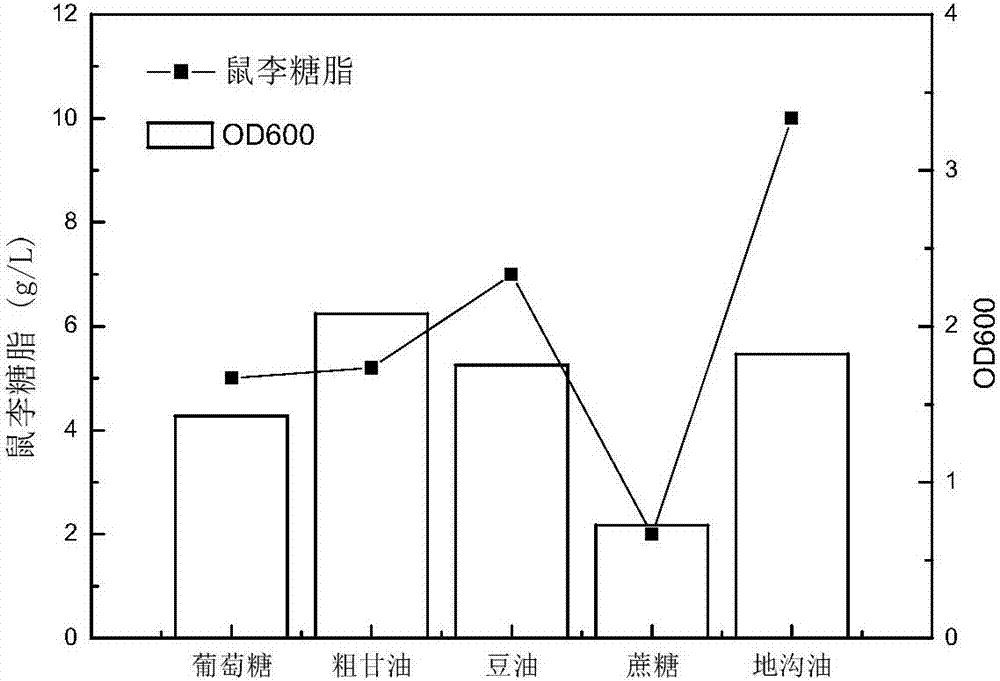Rhamnolipid high-yielding bacterial strain, and applications thereof
A rhamnolipid, high-yield technology, applied in the field of Pseudomonas aeruginosa, can solve the problems of restricting the application of rhamnolipid, high production cost, low yield, etc., achieve excellent surface activity, reduce production cost, and promote bacterial growth The effect of growth
- Summary
- Abstract
- Description
- Claims
- Application Information
AI Technical Summary
Problems solved by technology
Method used
Image
Examples
Embodiment 1
[0035] This example illustrates the method of performing ARTP mutagenesis on the original strain of Pseudomonas aeruginosa, and performing primary screening and secondary screening to screen excellent Pseudomonas aeruginosa.
[0036] The original strain of Pseudomonas aeruginosa CICC 21100 was derived from CICC, the specific method is as follows:
[0037] Helium was used as the gas, the ventilation flow rate was 10 L / min, the action distance was 2 mm, and the action power was 120 W. Dilute the seeds of Pseudomonas aeruginosa CICC 21100 with 0.9% saline to OD 600 =0.6, take 10 μL of the bacterial solution and evenly spread it on a sterile small iron sheet, air-dry it and put it in a breeding machine for 120 s of mutagenesis to obtain positive mutants.
[0038] Wherein, the medium formula used (% is mass percentage):
[0039] Blue gel slab primary screening: Dextrose 2.0%, KH 2 PO 4 0.07%, Na 2 HPO 4 0.09%, NaNO 3 0.2%, MgSO 4 ·7H 2 O 0.04%, CaCl 2 2H 2O 0.01%, CTAB...
Embodiment 2
[0058] This example illustrates the passage stability and taxonomic characteristics of the mutant strain KT1115.
[0059] The mutant strain KT1115 was subcultured and fermented every 12 h, and the rhamnolipid production of each generation of fermentation liquid was detected to observe whether there was a back mutation. The results are shown in Table 2.
[0060] Table 2 The rhamnolipid production of strain KT1115 with different generations
[0061]
[0062] From the experimental results, it can be seen that after 7 consecutive passages, the amount of rhamnolipid produced by the mutant strain KT1115 is relatively stable, and it has good passage stability, which can be used as a production strain for further research and development.
[0063] Taxonomic characteristics of the mutant strain KT1115: the cell size is 0.5-0.8 μm × 1.5-3.0 μm, with a single flagella. Colonies are flat with irregular edges.
Embodiment 3
[0065] This example illustrates Pseudomonas aeruginosa ( Pseudomonas aeruginosa ) strain KT1115 fermented to produce rhamnolipid with waste oil as the only carbon source.
[0066] Waste oil pretreatment: The waste oil collected from the canteen was first allowed to stand for 12 hours, and filtered with qualitative filter paper; then the filtrate was left to stand for 12 hours, and then filtered with qualitative filter paper, and the filtrate was obtained as waste oil for experiment.
[0067] The medium formula described in this embodiment (% is mass fraction):
[0068] Seed Medium: Peptone 1.0%, Yeast Extract 0.5%, Sodium Chloride 1.0%, pH 7.0.
[0069] Fermentation medium: waste oil 1.0%, NaNO 3 0.5%, KH 2 PO 4 0.1%, Na 2 HPO 4 12H 2 O 0.1%, MgSO 4 0.01%, FeSO 4 ·7H 2 O 0.02%, CaCl 2 2H 2 O 0.01%, pH6.0.
[0070] Inoculate 5 μL of Pseudomonas aeruginosa KT1115 stored at -80°C into 5 mL of LB seed medium, and culture overnight at 37°C and 200 rpm. The seed solu...
PUM
 Login to View More
Login to View More Abstract
Description
Claims
Application Information
 Login to View More
Login to View More - R&D
- Intellectual Property
- Life Sciences
- Materials
- Tech Scout
- Unparalleled Data Quality
- Higher Quality Content
- 60% Fewer Hallucinations
Browse by: Latest US Patents, China's latest patents, Technical Efficacy Thesaurus, Application Domain, Technology Topic, Popular Technical Reports.
© 2025 PatSnap. All rights reserved.Legal|Privacy policy|Modern Slavery Act Transparency Statement|Sitemap|About US| Contact US: help@patsnap.com



